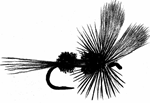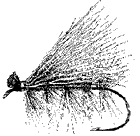

| Monthly Newsletter of the Central Texas Flyfishers | March, 2001 Vol. 7 No. 3 |
 |
 |
||
|
|||
President: Terry
Blackwell
Vice President: Joel Chavez
Conservation: Billy Wofford
Outings: Kevin Duren & Johnny Quiroz
Secretary: Kim Heaston
Treasurer: Bob Blagg

Terry brought meeting to order and welcomed all of the visitors and new members. He presented how he will run the meetings and the purpose of the club. Billy Wofford reported on the Kid Fish outing held on February 9th. A brief discussion about the Fly Fish 2001 show in Athens was followed by casting demonstrations and fly tying.

Nasty Weather Makes Fly Fish 2001 a Challenge
The reports are sketchy but it looks like the Fly Fish 2001 had some pretty miserable weather associated with it. Brian Watson's daughter became enamored of a largemouth bass in a tank and attempted to kiss the fish through the glass. Meanwhile Brian and Gabby caught a trout while being plastered by horizontal rain. Several reports came in about the travel hazards on the return trip but all made it home safely.
The following article is the first in a series that will outline the basics of fly fishing gear and terminology. It is being developed because there are a lot of new members who have either never used a fly rod or our out of practice but the information will be useful to the experienced fishermen as well. The first installment will be about rod selection.
There are several factors involved in choosing a fly rod. For the beginner the terminology can be confusing and sales people can be intimidating by trying to sell something you don't need. So, the first thing you need to know is what a rod is for.
The rod performs four functions. It presents the fly to your quarry, controls the fly, hooks the fish, and allows you to play and land the fish. The first requirement is obvious. The energy you supply to the rod is transmitted to the line, and subsequently, to the fly. The second requirement is a little more subtle. As you let your fly drift on the current it may become necessary to adjust how the fly is behaving either above or below the water. This is done by manipulating the rod and line. If one is so fortunate as to have a fish take your offering then you must use your rod to hook the fish firmly so that it will not get away. Finally, the rod gives you a mechanical advantage in playing the fish and bringing it to the net.
Now comes the decision as to what you will use this rod for. The type of rod you choose will depend on your fishing preferences. If you fancy sunfish (bluegill, pumpkinseed, or what the locals call "perch") you will not need a rod that was designed for tarpon fishing. The reverse is true. A rod designed for smaller fish will not have the stamina to horse that 13-pound bass you just hooked out of the weeds. This choice is a personal one but it is crucial to enjoying the sport. Your first rod must be suitable for what you want to do.
The rod "weight" will be a clue to the type of fishing it was designed for. The weight of a rod is determined by the size of the line that it will cast. That number is the weight of the first 30 feet of the fly line in grains (or there abouts). Smaller line weights, and rods, are for smaller fish. Be careful though. A one weight rod is great sport on small fish but will be more difficult to cast for a beginner than say a five weight and, because they are not common, more expensive. A three weight is the smallest I would recommend for the beginner and that is generous.
For the most part the larger the rod weight, the larger the fly that it can cast. If you plan to fish for trout or small bass you can expect to cast flies ranging from #4 nymphs or streamers to #20 dry flies. Three to five-weight rods will cast the small flies quite well but you would need to use seven or eight-weight rods to cast the larger flies. I would suggest a compromise and use a six-weight rod to try to cover the range.
What should your rod be made of? Currently there are three materials that rods are made of: fiberglass, graphite, and bamboo or cane. Fiberglass is heavier but can take a lot of abuse. It is cheaper and may fit into a budget more readily but you will soon want to upgrade. Graphite is the most common material used in modern rods. They are versatile, come in many price ranges, and are easier to cast with. Bamboo is what rods were made of before fiberglass and graphite came on the scene. There has been an upsurge in interest in bamboo because of its delicate presentation and because it can be hand crafted. They tend to be more expensive and not recommended for a beginner.

Rods come in different lengths that vary from 5' 6" to greater that 10". A longer rod requires more energy to cast but gives much better line control and longer casts. Shorter rods, while not requiring the energy to cast take away from line control. They do have their niche though. In close, brushy areas they are ideal. The rod length recommendation for a beginner is from 7' 6" to 9'.
Rod action is the last category I will discuss. In general rods are slow, medium, or fast. Slow action rods are great for delicate presentation of dry files. Fast action rods are stiffer and are good for distance casting. Again the recommendation for the beginner is to compromise and select a medium action rod to give you most of the range of both types.
In summary the beginner should choose a rod that fits his or her needs. For learning to cast and fishing the local fresh water streams, ponds, and lakes a medium action graphite rod, six weight from 7' 6" to 9' in length is a good choice.
Kim Heaston
Once again February has come and gone, leaving us with hope for the springtime and aspirations of being able to catch a few white bass. With a little more than four weeks until daylight savings time returns, the sunlight begins to linger closer to 7 p.m. giving us time to unwind from our daily labors and ready to enjoy the more important things in life, family and friends.
On a recent trip to the Kerrville area, I was once again reminded how much fun it is to fish like a kid. Remember as a kid, how you'd try to fish under docks, bridges and other easy to access spots? I remember not having much luck doing so, but this day was different. Bass and panfish were stacked underneath a bridge below a low water dam. To catch our finned friends, you had to cast into the shade and let it sink to bounce along the bottom and be ready to strike (okay, so it only took a second or so). It was great practice for casting into low openings. The most rewarding part of this endeavor was to see the smiles on those who made the trip with me. We must have caught well over 100 fish between the five of us, not to mention a little too much sun.
A recent evening found me along the shores of Brushy Creek, not far from where I live, watching perch voraciously feed during the evening's Caddis hatch. Fortunately for them, the light was quickly fading, and my tippet needed replacing. Without a light tippet my dead drifts were too dead. Of course, this means I'll be back with a light rod and finer tippet, when once again I travel around the next bend
Michael Brown

©
2001 Central Texas Flyfishers
|
Home
| About | Meetings
| Calendar | Outings
| Newsletter |